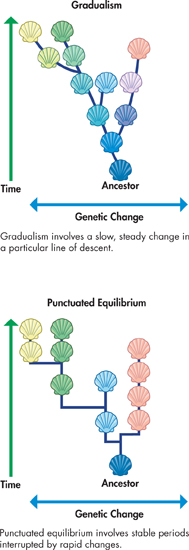Rate of Evolution
 How fast does evolution take place?
How fast does evolution take place?
How quickly does evolution operate? Does it always take place at the same speed?  Evidence shows that evolution has often proceeded at different rates for different organisms at different times over the long history of life on Earth. Two models of evolution—gradualism and punctuated equilibrium—are shown in Figure 19–10.
Evidence shows that evolution has often proceeded at different rates for different organisms at different times over the long history of life on Earth. Two models of evolution—gradualism and punctuated equilibrium—are shown in Figure 19–10.
Gradualism Darwin was impressed by the slow, steady pace of geologic change. He suggested that evolution also needed to be slow and steady, an idea known as gradualism. The fossil record shows that many organisms have indeed changed gradually over time.
Punctuated Equilibrium However, numerous examples in the fossil record indicate that the pattern of slow, steady change does not always hold. Horseshoe crabs, for example, have changed little in structure from the time they first appeared in the fossil record. Much of the time, these species are said to be in a state of equilibrium. This means that their structures do not change much even though they continue to evolve genetically.
Every now and then something happens to upset this equilibrium for some species. Punctuated equilibrium is the term used to describe equilibrium that is interrupted by brief periods of more rapid change. (Remember that we use rapid here relative to the geologic time scale. For geologists, rapid change can take thousands of years!) The fossil record does reveal periods of relatively rapid change in particular groups of organisms. In fact, some biologists suggest that most new species are produced during periods of rapid change.

FIGURE 19–10 Models of Evolution Biologists have considered two different patterns for the rate of evolution, gradualism and punctuated equilibrium. These illustrations are simplified to show the general trend of each model. Interpret Visuals How do the diagrams illustrate these two models?
dddRapid Evolution After Equilibrium There are several reasons why evolution may proceed at different rates for different organisms at different times. Rapid evolution may occur after a small population becomes isolated from the main population. This small population can evolve faster than the larger one because genetic changes spread more quickly among fewer individuals. Rapid evolution may also occur when a small group of organisms migrates to a new environment. That's what happened with the Galápagos finches. In addition, mass extinctions open many ecological niches, creating new opportunities for those organisms that survive. It's not surprising, then, that groups of organisms that survive mass extinctions evolve rapidly in the several million years after the extinction.
 In Your Notebook In your own words, describe gradualism and punctuated equilibrium.
In Your Notebook In your own words, describe gradualism and punctuated equilibrium.
Table of Contents
- Formulas and Equations
- Applying Formulas and Equations
- Mean, Median, and Mode
- Estimation
- Using Measurements in Calculations
- Effects of Measurement Errors
- Accuracy
- Precision
- Comparing Accuracy and Precision
- Significant Figures
- Calculating With Significant Figures
- Scientific Notation
- Calculating With Scientific Notation
- Dimensional Analysis
- Applying Dimensional Analysis




